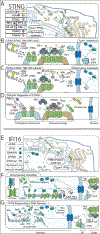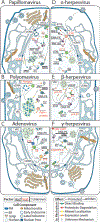Nuclear antiviral innate responses at the intersection of DNA sensing and DNA repair
- PMID: 35641341
- PMCID: PMC9560981
- DOI: 10.1016/j.tim.2022.05.004
Nuclear antiviral innate responses at the intersection of DNA sensing and DNA repair
Abstract
The coevolution of vertebrate and mammalian hosts with DNA viruses has driven the ability of host cells to distinguish viral from cellular DNA in the nucleus to induce intrinsic immune responses. Concomitant viral mechanisms have arisen to inhibit DNA sensing. At this virus-host interface, emerging evidence links cytokine responses and cellular homeostasis pathways, particularly the DNA damage response (DDR). Nuclear DNA sensors, such as the interferon (IFN)-γ inducible protein 16 (IFI16), functionally intersect with the DDR regulators ataxia telangiectasia mutated (ATM) and DNA-dependent protein kinase (DNA-PK). Here, we discuss accumulating knowledge for the DDR-innate immunity signaling axis. Through the lens of this infection-driven signaling axis, we present host and viral molecular strategies acquired to regulate autoinflammation and antiviral responses.
Keywords: DNA damage response; DNA virus infection; antiviral response; interferon; nuclear DNA sensing.
Copyright © 2022 Elsevier Ltd. All rights reserved.
Conflict of interest statement
Declaration of interests No interests are declared.
Figures




Similar articles
-
DNA-PK and ATM drive phosphorylation signatures that antagonistically regulate cytokine responses to herpesvirus infection or DNA damage.Cell Syst. 2024 Apr 17;15(4):339-361.e8. doi: 10.1016/j.cels.2024.03.003. Epub 2024 Apr 8. Cell Syst. 2024. PMID: 38593799 Free PMC article.
-
Charge-Mediated Pyrin Oligomerization Nucleates Antiviral IFI16 Sensing of Herpesvirus DNA.mBio. 2019 Jul 23;10(4):e01428-19. doi: 10.1128/mBio.01428-19. mBio. 2019. PMID: 31337724 Free PMC article.
-
Biphasic Functional Interaction between the Adenovirus E4orf4 Protein and DNA-PK.J Virol. 2019 May 1;93(10):e01365-18. doi: 10.1128/JVI.01365-18. Print 2019 May 15. J Virol. 2019. PMID: 30842317 Free PMC article.
-
Human Papillomaviruses Target the DNA Damage Repair and Innate Immune Response Pathways to Allow for Persistent Infection.Viruses. 2021 Jul 17;13(7):1390. doi: 10.3390/v13071390. Viruses. 2021. PMID: 34372596 Free PMC article. Review.
-
Viral Modulation of the DNA Damage Response and Innate Immunity: Two Sides of the Same Coin.J Mol Biol. 2022 Mar 30;434(6):167327. doi: 10.1016/j.jmb.2021.167327. Epub 2021 Oct 22. J Mol Biol. 2022. PMID: 34695379 Free PMC article. Review.
Cited by
-
Intercellular communication within the virus microenvironment affects the susceptibility of cells to secondary viral infections.Sci Adv. 2023 May 10;9(19):eadg3433. doi: 10.1126/sciadv.adg3433. Epub 2023 May 10. Sci Adv. 2023. PMID: 37163594 Free PMC article.
-
Herpes simplex virus infected cell protein 8 is required for viral inhibition of the cGAS pathway.Virology. 2023 Aug;585:34-41. doi: 10.1016/j.virol.2023.05.002. Epub 2023 May 25. Virology. 2023. PMID: 37271042 Free PMC article.
-
The PYRIN domain is required for TLR4-mediated inflammation by PYHIN family members.iScience. 2025 Apr 11;28(5):112413. doi: 10.1016/j.isci.2025.112413. eCollection 2025 May 16. iScience. 2025. PMID: 40454096 Free PMC article.
-
Deciphering the phospho-signature induced by hepatitis B virus in primary human hepatocytes.Front Microbiol. 2024 May 22;15:1415449. doi: 10.3389/fmicb.2024.1415449. eCollection 2024. Front Microbiol. 2024. PMID: 38841065 Free PMC article.
-
Infection-induced lysine lactylation enables herpesvirus immune evasion.Sci Adv. 2025 Jan 10;11(2):eads6215. doi: 10.1126/sciadv.ads6215. Epub 2025 Jan 8. Sci Adv. 2025. PMID: 39772686 Free PMC article.
References
Publication types
MeSH terms
Substances
Grants and funding
LinkOut - more resources
Full Text Sources
Research Materials
Miscellaneous

